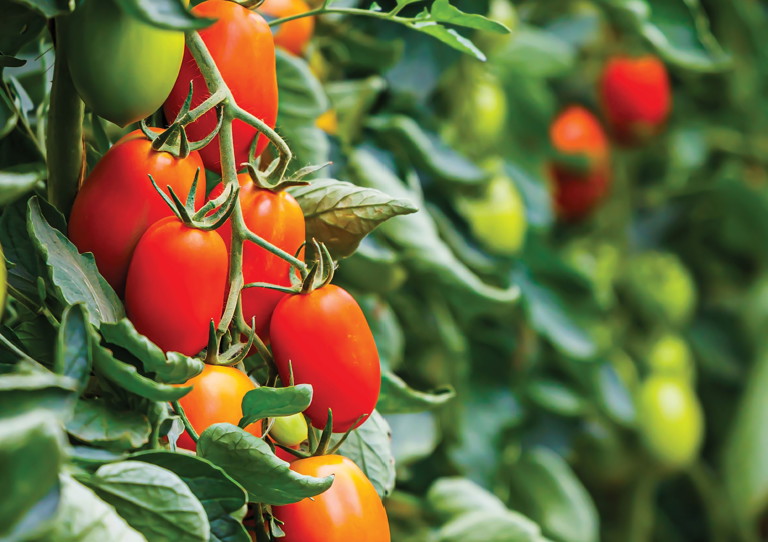
Tough tomatoes
Disease-resistant varieties of tomatoes are upping the fight against soil-borne fusarium wilt.
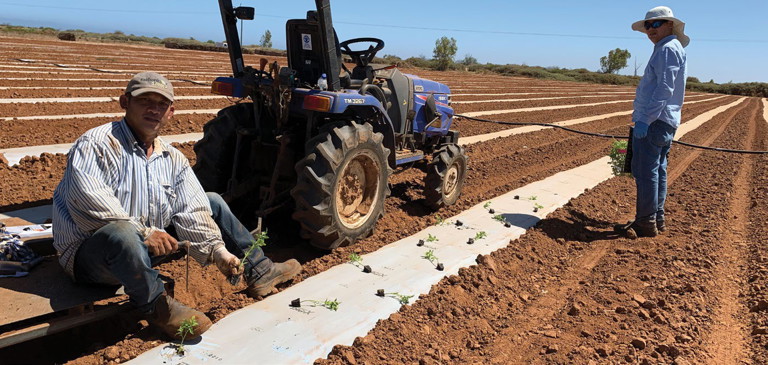
PLANTING the tomato trial on-farm.


BY GIAO NGUYEN (LEFT) AND CRAIG WEBSTER
RESEARCH SCIENTIST, VEGETABLES, DPIRD
& LABORATORY RESEARCH SCIENTIST, DPIRD
Fusarium wilt (Fusarium oxysporum f.sp. lycopersici), sometimes called fusarium canker, is a critical issue for tomato growers in Carnarvon.
Fusarium fungi live in the soil and can survive for many years without a host. The fungus enters through the roots and builds up in the vascular tissue as it spreads through the plant. This causes blockage of the vascular tissues so the plants cannot take up water and nutrients adequately, resulting in yellowing, wilting and finally death of the above ground plant parts.
Infected plants usually show serious symptoms when they reach the fourto-five truss stage. This disease is destructive, significantly reducing yield and overall production. In addition to fusarium pathogens, Carnarvon plantations often have high levels of soil borne nematodes (Meloidogyne spp.), which affect crop growth. In the root zone, nematode attacks can reduce the resistance of plants to pathogens and increase their susceptibility to infection by fusarium.
Currently, there is no method to eradicate the fusarium completely from a paddock if it is established in an area. However, several measures are recommended to alleviate the detrimental effects of the disease:
• Apply fumigants to reduce the level of fusarium in the soil.
• Use resistance varieties.
• Apply crop rotations.
• Decontaminate tools and equipment between fields.
• Maintain a balanced fertilising program avoiding excessive nitrogen.
“ … the use of disease-resistant varieties is a simple and practical farming method [and] one that tomato growers in Carnarvon can apply to effectively deal with the soil-borne fusarium wilt and other related diseases. ”
Tomato growers in Carnarvon often use fumigants in an attempt to eliminate all soil-borne pathogens, including fusarium wilt. However, the fumigation is only effective if the fumigants are applied correctly and reach sufficient concentrations throughout the whole soil profile, which is impractical to achieve. Crop rotations are not always feasible, especially for small farm size holders and farm renters or sharers. Using stringent hygiene protocols and appropriate fertilising programs requires additional effort from growers and an increase in labour costs. Managing the pathogens through the use of resistant cultivars is one of the most costeffective methods of controlling both fusarium wilt and root knot nematode.
In autumn 2022, the Department of Primary Industries and Regional Development (DPIRD) conducted an on-farm trial at the Ho and Nguyen Plantation in Carnarvon. The trial was a randomised complete block design with three replicates and five tomato varieties. Four resistant tomato varieties were kindly provided by seed companies, Rifle (Syngenta), Adira (HM Clause), Monaro (HM Clause) and Babinda (Bayer).
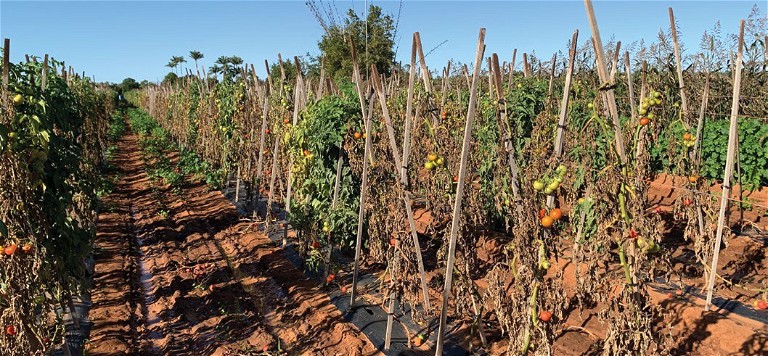
THE tomato crop infected with fusarium wilt.
The varieties contain genes resistant to all three strains of fusarium wilt (Fol 1, 2, 3) and root knot nematodes (Mi). The grower’s susceptible variety Arendell (Nunhems) was used as the control. Arendell contains all resistant genes to root knot nematodes (Mi), but it has only genes resistant to two strains of fusarium wilt (Fol 1, 2). Soil test results before and after the fumigation, confirmed the existence of the fusarium wilt pathogen and a small amount of root knot nematodes (data not shown). The trial was planted on March 18 last year and completed on July 9 in the same year.
The results showed that all resistant varieties survived well, while susceptible variety Arendell exhibited a dead and/or dying symptom ratio between 40% and 60% on the infected soil (Table 1). The results also suggest that the fusarium wilt race 3 (Fol 3) is present in Carnarvon, but is well controlled by commercially available varieties containing race 3 resistance genes.
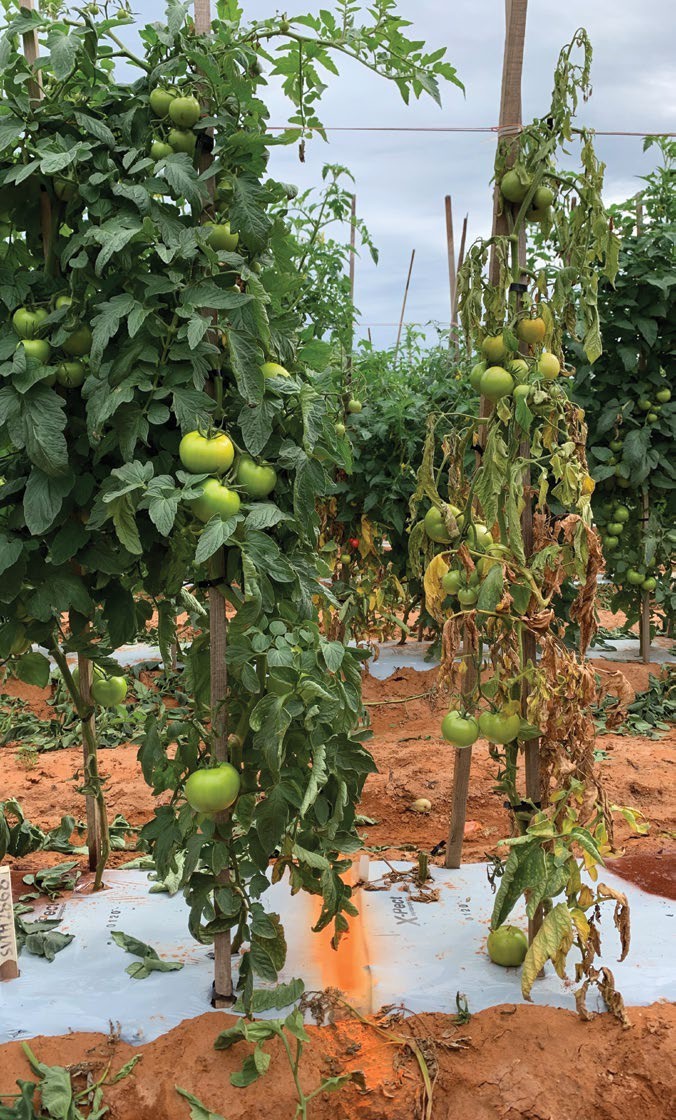
RESISTANT versus susceptible variety for fusarium wilt. Left: Babinda; right: Arendell.
TABLE 1. INFECTION RATE OF RESISTANT AND SUSCEPTIBLE VARIETIES.
“ My vegetable farm has had issues with soil-borne pathogens for years... I was impressed with the results of the trial, which demonstrated promising solutions for my problematic soil. ”
Babinda variety has the highest marketable fruit yield per plant (4.3kg), followed by Monaro (3.59kg) (see Figure 1). Arendell had the lowest marketable fruit yield per plant (3.2kg). Among the varieties, Babinda had the largest average fruit weight (180g, data not shown) and attractive skin colour and firmness, satisfying market requirements.
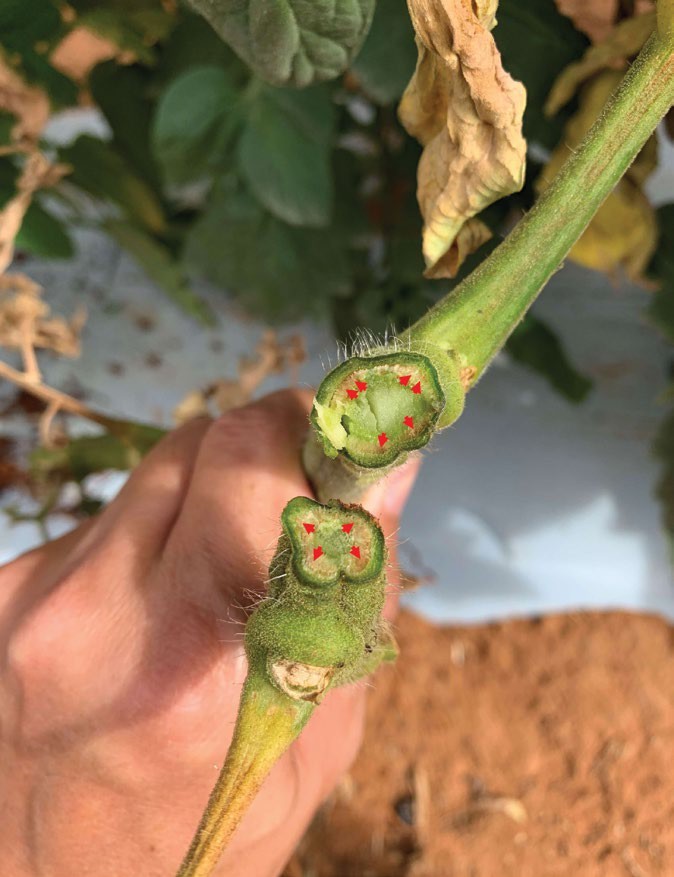
THE symptom of fusarium wilt infection on a tomato plant. Note the browning of vascular tissue inside the stem.
Overall, this initial trial using resistant varieties has demonstrated the use of disease-resistant varieties is a simple and practical farming method. And it is one that tomato growers in Carnarvon can apply to effectively deal with soil-borne fusarium wilt and other related diseases.
The study also suggested that it is necessary to use a combination of crop management practices, such as soil fumigation and disease-resistant varieties to improve control over soilborne pathogen issues, such as fusarium wilt, and to stabilise crop production.
DPIRD’s Carnarvon Office is working closely with seed companies to identify vegetable varieties that have disease resistance and quality traits. Growers who would like to participate in on-farm vegetable variety trials in Carnarvon are encouraged to contact DPIRD to discuss further.

The feedback
DPIRD had an informal discussion with farm owner Kiem Ho for his opinion after the trial was completed – here’s what he had to say…
“My vegetable farm has had issues with soil-borne pathogens for years. I have tried various remedies that have been unsuccessful. This was the first time I participated in an on-farm trial with DPIRD. I was impressed with the results of the trial, which demonstrated promising solutions for my problematic soil. I am planning to implement a comprehensive approach combining fumigation and resistant tomato varieties in my routine agronomic practices from now on.”
Kiem is particularly interested in one of the varieties in the trial, Babinda, which demonstrated resistance, the highest yield and outstanding marketing quality. He is willing to participate in more of DPIRD’s trials and encourages other growers to take part in collaborative research projects with the department. Kiem is looking forward to seeing additional technologies developed for vegetable growers.
MORE INFORMATION
Contact Giao Nguyen on (08) 9956 3327 or contact Craig Webster on (08) 9368 3139 or email giao.nguyen@dpird.wa.gov.au; or email craig.webster@dpird.wa.gov.au.